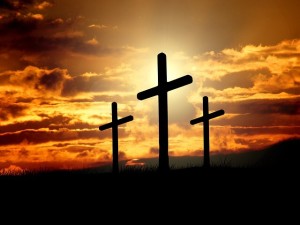
We cracked open the book, ready for our daily reading of Scripture and devotional time together. My girls got excited when they saw the picture of an angel standing beside an open tomb. “Mama, we get to read about how Jesus was raised from the dead today!!” You would think they won the “devotional lottery,” and it’s true.
The Life, Passion, and Resurrection of Christ is the greatest story ever told.
We walked through the account in the book of Luke slowly, deliberately imagining each moment of that miraculous and glorious morning.
I felt the dew in the early morning air and the deep love mixed with sorrow in the hearts of the two women as they approached Christ’s tomb.
My girls questions began immediately: “I wonder what the guards did when they saw the angel?!” one of my daughters asked excitedly. “I wonder if the angel was Gabriel – or another angel?” “I wonder what the angel looked like! He scared the guards!”
Seeing a Familiar Story with New Eyes

I’ve read the story of Christ’s resurrection hundreds of times. Like many familiar passages in Scripture, it can, unfortunately, be easy to read a story like Jesus miraculously feeding 5,000 people and then go take out the trash and forget all about it. I’m just being an honest adult here.
But these stories are not just stories. They are accounts of what God did when He came to earth. And my daughters eager imaginations at work beckoned me to look at this account of Christ’s resurrection with new eyes again.
“Isn’t it cool that the first people to see Him raised from the dead were women?!” I chimed in with joy. “Yeah,” they answered in affirmation. “What would I do if I were Mary and I saw Him?,” Chesed asked.
We then read about how he appeared to several disciples as they were gathered together. “How did they know it was Him?,” I asked my girls. “The holes from the nails on his hands and feet,” Grace said. “And the place where the sword cut him in the side,” Chesed said as she touched her own side thoughtfully.
We talked about the wounds of Christ that day. We talked about Heaven, too, and how Jesus would be the only one in Heaven who still bore wounds of any kind.
I shared stories of how both my husband and I were injured in various ways as children that left scars on various parts of our bodies. I said, “Mommy and Daddy’s scars will be gone when we go to Heaven, but Jesus will always be able to show us His hands, feet, and side.”
The girls wanted to know if the tomb really looked like the picture in our story. I said, “Well, do you want to see a picture of the tomb they believe He was in?” Um, of course they did. I pulled up a picture of the Garden Tomb in Jerusalem, which I have stood in myself. They begged me to go there to see it themselves with their own eyes. “Someday,” I said, eyes twinkling.
Don’t Just Read the Story – Revel in It!
That day, my daughters and I didn’t just read a story. We reveled in a real-life account that became alive to each of us in a new way.
Because of my children’s eyes – fresh and new – I read that account like it was the first time I had ever heard it.
And I sat amazed in jaw-dropping wonder once again about the God who not only would send His Son to die for my sins but also has complete authority and power over death – indeed, He holds the keys to death, hell, and the grave.
This Holy Week, let’s read this amazing story with new eyes. Let’s revel in the miraculous.
Let’s let our eyes squint from the brightness of the angel.
Let’s allow our hearts to rise into our throats like the women who raced back to tell the rest of the disciples just whom they had seen that morning.
Let’s stand in wonder once again at an empty tomb – and all that it means for our lives today.






